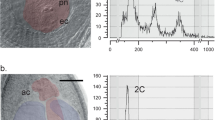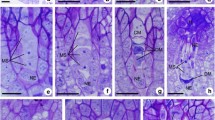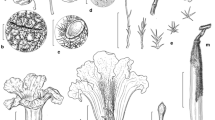Summary
Changes in incidence of apomixis were determined at different intervals of the flowering period in a highly sexual diploid cytotype of Paspalum cromyorrhizon Trin., a natural tetraploid cytotype of the same species, and in the triploid and tetraploid intraspecific hybrids that were produced by pollinating the 2x cytotype with pollen of the tetraploid. Reproductive behaviour was determined from observations of embryo sacs in mature ovules. Gametophytic apomixis in this species in characterized by aposporous embryo sacs which differ from normal sacs by their number, orientation inside the ovule, their dimensions and shape, and the absence of antipodal cells.
The potential for apomictic reproduction increased in relation to the ploidy level, suggesting a gene dosage effect in the incidence of apomixis. In the three ploidy levels, the highest incidence of apomixis was observed when the plants reached the maximum number of flowering heads. These findings suggest that the same environmental conditions that favour flowering should also be responsible for increasing the incidence of apomixis. An additional experiment under controlled conditions indicated that the light regime should be one of the factors that govern the amount of apomictic reproduction. Thus, polyploidy and apomixis should be of special significance in the dispersion and evolution of this grass species. The 4x facultative apomictic cytotype is far more frequent in nature than the highly sexual 2x. Moreover, most of the seeds produced in a flowering season should arise asexually. So, apomixis rapidly increases the number of plants bearing the successful maternal genotype, and sexual reproduction becomes important in adverse environmental conditions.
Similar content being viewed by others
References
Burton, G. W., 1948. The method of reproduction in Common Bahia Grass, Paspalum notatum. J. Amer. Soc. Agron. 40: 443–452.
Burton, G. W., 1974. Recurrent restricted phenotypic selection increases forage yields of Pensacola Bahiagrass. Crop Sci. 14: 831–835.
Knox, R. B., 1967. Apomixis: seasonal and population differences in a grass. Science 157: 325–326.
Millot, J. C., 1977. Sexuality in Paspalum dilatatum Poir. ssp. dilatatum. III Congreso Latinoamericano de Genética, Montevideo, Uruguay. Pag. 252.
Norrmann, G. A., 1981. Citología y método de reproducción en dos especies de Paspalum (Gramineae). Bonplandia 5: 149–158.
Quarin, C. L. & W. W., Hanna, 1980. Effect of three ploidy levels on meiosis and method of reproduction in Paspalum hexastachyum. Crop Sci. 20: 69–75.
Quarin, C. L., W. W., Hanna & A., Fernandez, 1982. Genetic studies in diploid and tetraploid Paspalum species. J. Heredity 73: 254–256.
Quarin, C. L., B. L., Burson & G. W., Burton, 1984. Cytology of intra-and interspecific hybrids between two cytotypes of Paspalum notatum and P. cromyorrhizon. Bot. Gaz. 145: 420–426.
Author information
Authors and Affiliations
Rights and permissions
About this article
Cite this article
Quarin, C.L. Seasonal changes in the incidence of apomixis of diploid, triploid, and tetraploid plants of Paspalum cromyorrhizon . Euphytica 35, 515–522 (1986). https://doi.org/10.1007/BF00021860
Received:
Issue Date:
DOI: https://doi.org/10.1007/BF00021860




